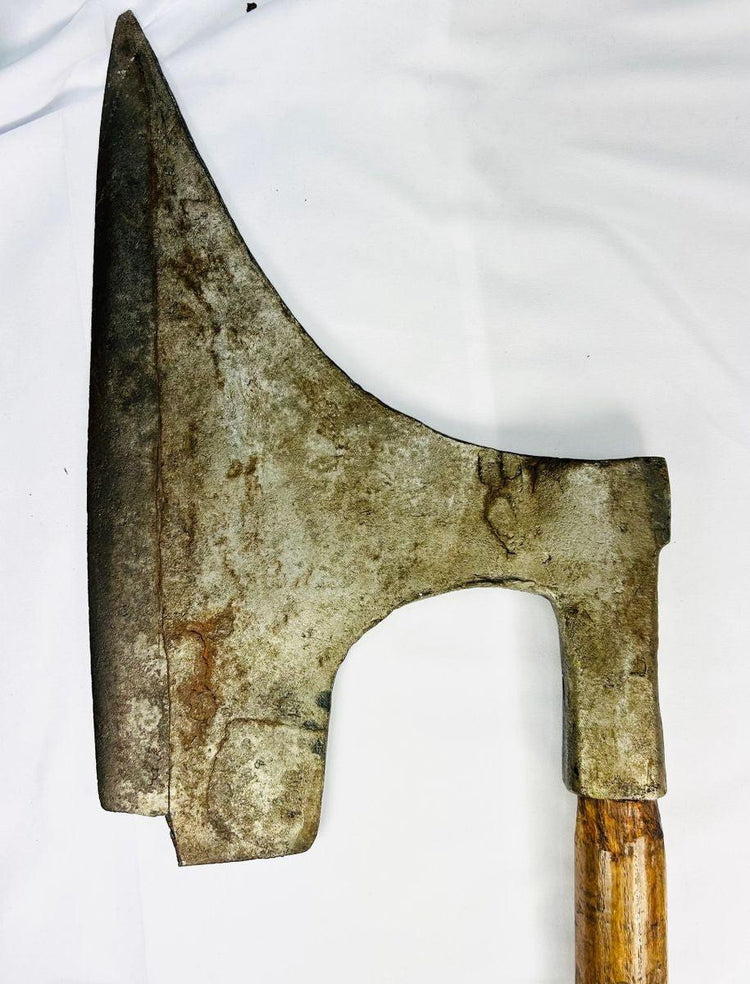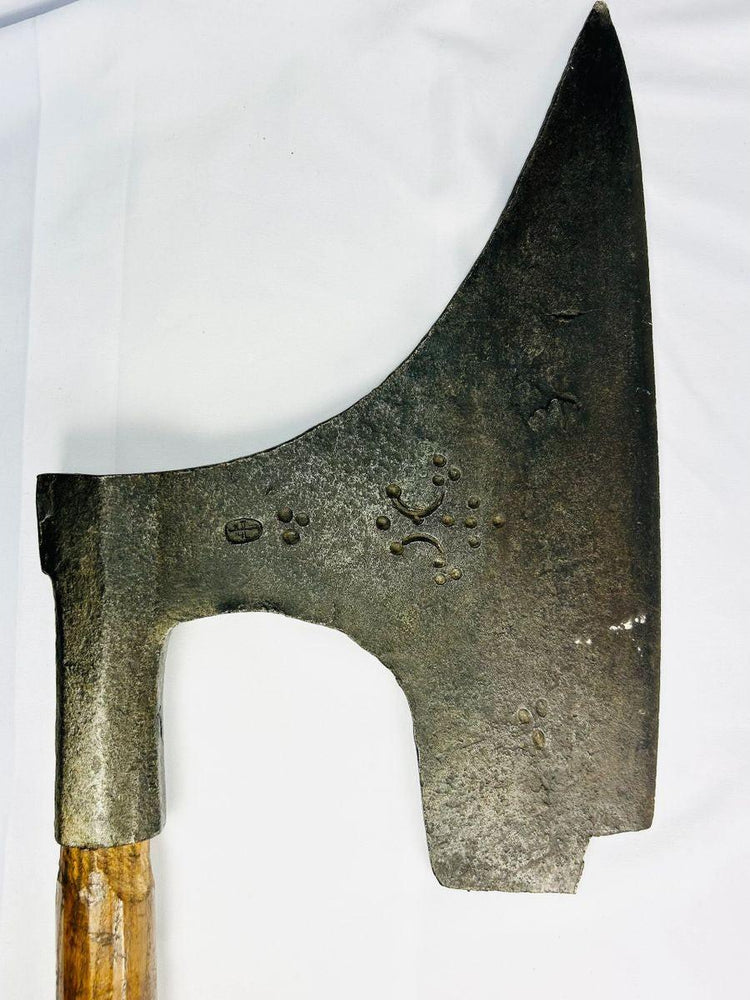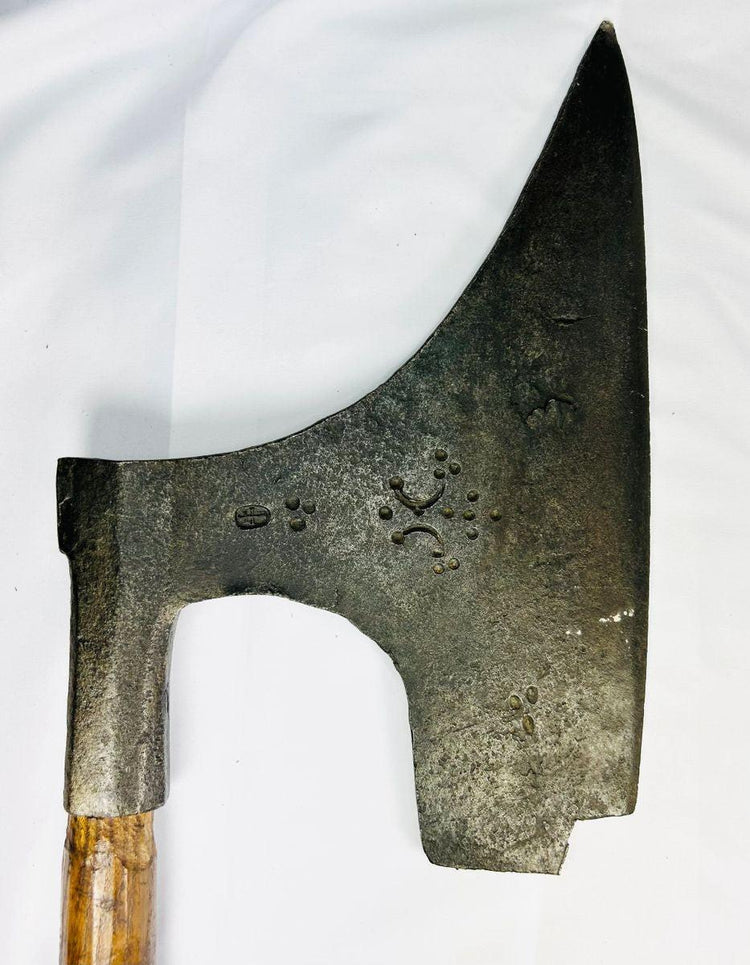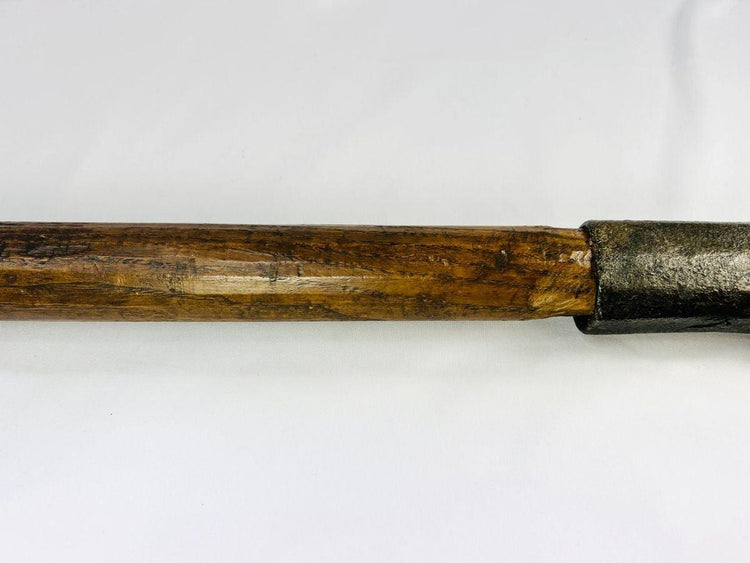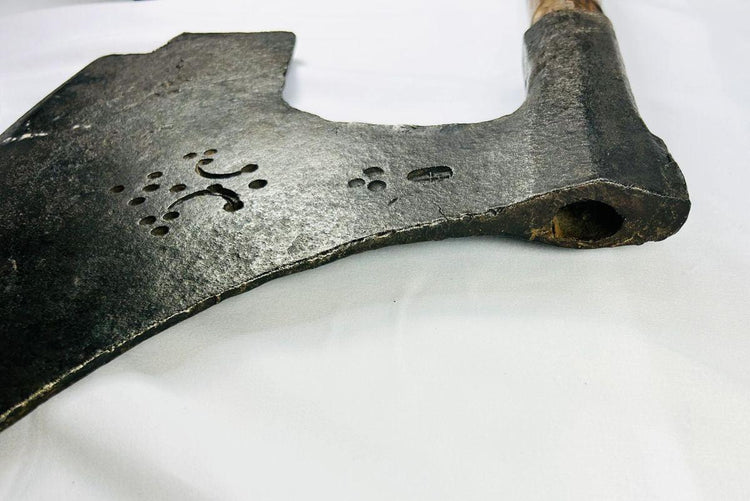German or Scandinavian Executioner’s Axe | Forged Iron Blade with Guild Stamps | 18th Century
Description
More
Less
Historical Context & Origin
Region: Central or Northern Europe (likely German or Scandinavian states)
Material: Hand-forged iron blade, later hardwood handle
Period: Circa 18th Century (blade); handle likely 19th–20th century replacement
Description
This imposing hand-forged iron axe is a rare example of European blade craftsmanship, stylistically aligned with executioner’s or ceremonial axes of Germanic and Scandinavian traditions. The broad, curved blade with a deep drop beneath the socket, combined with a flat poll, suggests a purpose rooted in judicial or symbolic use rather than warfare. Its balance indicates controlled, deliberate handling, reinforcing interpretations of ritual or penal applications.
The reverse side of the blade bears distinctive forge stamps—crescent moons, clustered dots, and an oval cartouche with a cross-like device—consistent with Continental smithing symbolism found in the Holy Roman Empire and Scandinavian states during the 1700s. Such stamps often carried workshop or guild significance, while also serving as protective or judicial emblems. The wooden haft, though a later replacement, was crafted in period style to match original proportions and has aged naturally.
Features
- Broad, curved executioner-style blade with flat poll
- Distinctive forge stamps: crescents, dot clusters, and cross-like oval cartouche
- Dark patinated surface with age-consistent wear
- Later hardwood shaft replacement, securely fitted to original socket
- Hollow-eyed socket with traditional forge taper
Cultural Significance
Axes of this form held profound symbolic and judicial weight in early modern Europe. Beyond their practical role, they embodied authority, justice, and punishment—whether used in ceremonial executions or as theatrical representations of state power. Executioners, often feared yet essential figures, passed such blades through generations, imbuing them with legend and cultural resonance. Even if not wielded in an actual execution, this axe stands as a potent relic of Enlightenment-era law, ritual, and authority.
Condition
Blade shows heavy age patina with minor edge flaking and forging pits. All stamps remain clearly visible and well-preserved. Handle is secure, with age-related wear but structurally sound. No active corrosion; excellent for display.
Dimensions (approximate)
Blade Width (edge to poll): 10.25 in
Blade Height: 15.5 in
Overall Length: 44.5 in
Age
Blade: Circa 18th century
Handle: 19th–20th century replacement
Description
Historical Context & Origin
Region: Central or Northern Europe (likely German or Scandinavian states)
Material: Hand-forged iron blade, later hardwood handle
Period: Circa 18th Century (blade); handle likely 19th–20th century replacement
Description
This imposing hand-forged iron axe is a rare example of European blade craftsmanship, stylistically aligned with executioner’s or ceremonial axes of Germanic and Scandinavian traditions. The broad, curved blade with a deep drop beneath the socket, combined with a flat poll, suggests a purpose rooted in judicial or symbolic use rather than warfare. Its balance indicates controlled, deliberate handling, reinforcing interpretations of ritual or penal applications.
The reverse side of the blade bears distinctive forge stamps—crescent moons, clustered dots, and an oval cartouche with a cross-like device—consistent with Continental smithing symbolism found in the Holy Roman Empire and Scandinavian states during the 1700s. Such stamps often carried workshop or guild significance, while also serving as protective or judicial emblems. The wooden haft, though a later replacement, was crafted in period style to match original proportions and has aged naturally.
Features
- Broad, curved executioner-style blade with flat poll
- Distinctive forge stamps: crescents, dot clusters, and cross-like oval cartouche
- Dark patinated surface with age-consistent wear
- Later hardwood shaft replacement, securely fitted to original socket
- Hollow-eyed socket with traditional forge taper
Cultural Significance
Axes of this form held profound symbolic and judicial weight in early modern Europe. Beyond their practical role, they embodied authority, justice, and punishment—whether used in ceremonial executions or as theatrical representations of state power. Executioners, often feared yet essential figures, passed such blades through generations, imbuing them with legend and cultural resonance. Even if not wielded in an actual execution, this axe stands as a potent relic of Enlightenment-era law, ritual, and authority.
Condition
Blade shows heavy age patina with minor edge flaking and forging pits. All stamps remain clearly visible and well-preserved. Handle is secure, with age-related wear but structurally sound. No active corrosion; excellent for display.
Dimensions (approximate)
Blade Width (edge to poll): 10.25 in
Blade Height: 15.5 in
Overall Length: 44.5 in
Age
Blade: Circa 18th century
Handle: 19th–20th century replacement
You May Also Like


























